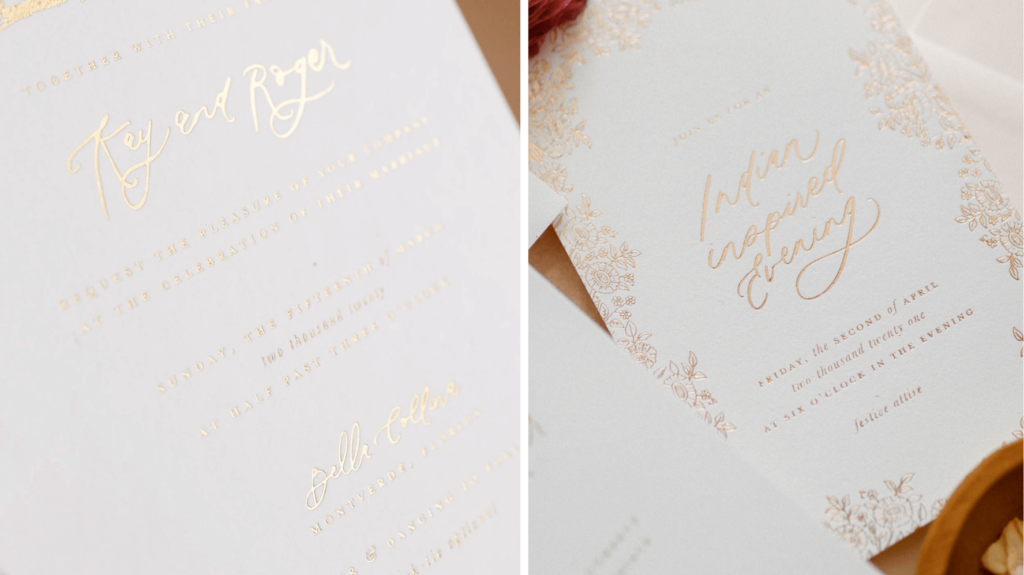
April 25, 2023
All About Printing Styles
Every engaged couple we meet with wants their wedding invitations to be stunning and unique. The printing methods that you choose for an invitation suite can truly set it apart from the rest and create that “wow” moment when your guests first open them. From classic letterpress to modern digital printing, there are many options to choose from when it comes to creating your perfect wedding invitation suite. Each of these printing styles varies in complexity and price point. And very often, our designs combine two or more printing styles, depending on the complexity of the design.
Let’s dive into the wonderful world of wedding invitation printing methods and find the one that’s right for you!
DIGITAL PRINTING – $

Digital printing uses digital technology to print an image or design directly onto paper or other materials. In this type of printing, we create the design of your invitation and then send it to a digital printer. This printer uses an inkjet or laser process to print the design onto the paper of choice, similar to your home printer, just on a more sophisticated, finished, and precise level.
Each of our semi-custom wedding invitation suite designs uses digital printing, which is why we can place them at an affordable price point.

Our semi-custom invitation line uses digital printing
Digital printing is a great option for creating beautiful and personalized wedding invitations. One of the biggest benefits is that it allows for a wide array of customization options, including basically unlimited colors and designs. Some of our most beautiful and colorful invitations use digital printing. In addition, any custom watercolor designs we create for your invitations are printed digitally.
Some might worry that you lose the options for texture when you use digital printing, but you can pair it with a textured paper selection to achieve a unique finish. A perfect example of this is our Lucia semi-custom suite, which is printed digitally on deckled-edge paper.

Gold foil and deckled-edge paper add texture to this digitally-printed invitation. This is the Lucia suite from our semi-custom line.
Plus, digital printing can often be done quickly and at a lower cost than other methods of printing wedding invitations. If you value customization and cost-effectiveness, then digital printing could be a great choice.
FOIL PRINTING – $$

Foil printing is a print method that uses heat and pressure to apply metallic foil to paper. We create the invitation’s design, and then a metal die is created with the design etched into it. This is how the foil transfers onto the paper. Then, the foil color is selected and placed onto the die. The die is heated and pressed onto the paper, transferring the foil onto the desired areas of the invitation. This process creates a beautiful metallic finish.
Foil printing is a classic, luxurious, and eye-catching option for wedding invitations. One of the biggest benefits of foil printing is that it adds elegance and romance to your invitations that can’t be achieved with other printing methods. Foil can come in a range of shades, like gold, silver, and rose gold, which can really make your invitations stand out and add a special touch to your wedding stationery.
LETTERPRESS – $$$
Letterpress printing is a traditional printing method that involves pressing a design into paper to create a textured and elegant effect. We create the design and then a metal or polymer plate is created with the design etched into it, which is then used to transfer the design onto the paper. Thicker and softer paper is used for letterpress to better absorb the impression from the press. The plate is then inked and pressed into the paper, creating a deep impression and a unique texture. Each color is printed separately, so multiple plates may be used for a single design.

Letterpress printing is a classic and elegant option for wedding invitations. One of the biggest benefits of letterpress printing is that it creates a tactile effect that can’t be achieved with other printing methods. The design is pressed into the paper, creating a deep impression and a unique texture that is perfect for those who want a more traditional and sophisticated look.
BLIND DEBOSS – $$$

Blind deboss creates a similar textured effect as letterpress, but without ink. The design is etched into a plate and pressed into the paper. In some cases, a second plate is used to create a blind deboss effect with additional details or a different level of depth. This is less common than using a single plate for blind deboss printing, but it can be done in certain circumstances.

This suite combines two printing styles, with blind deboss in the floral border with letterpress for the wording.
One of the biggest benefits of blind debossing is that it creates a beautiful texture and depth to your invitations without adding any color or ink. This provides an understated effect that is perfect for those who want to keep their wedding stationery simple and elegant. It is a great choice for those who want a subtle and sophisticated effect on their wedding invitations. The level of detail it requires means that it is the most costly printing method.
A Unique Printing Style For Every Bride
Each printing style brings something unique and special to your invitations. And ultimately, your goals for your invitations will truly help determine the printing types that are best for your suite. The best thing about working with AM+Co for your invitations? You don’t have to use just one type! We love creating suites that incorporate multiple printing styles so that your invitations are truly 100% custom. We’re here to help guide you through the process! We design invitations that speak to how beautiful and extraordinary your love story is. We’re experts at walking our brides through the invitation process, from vision, design, paper selection, printing style, and finished product.
Contact us today to discuss your invitation dreams – we’d love to talk and help take you from vision to reality!

Leave a Reply
You must be logged in to post a comment.

[…] truly spared no expense on her invitations, and it shows! This was the first time we used blind deboss printing, which creates depth and texture without ink. The invitation had a double pocket and was […]